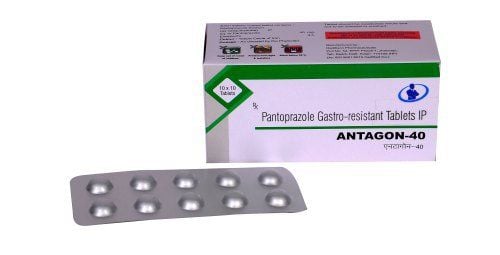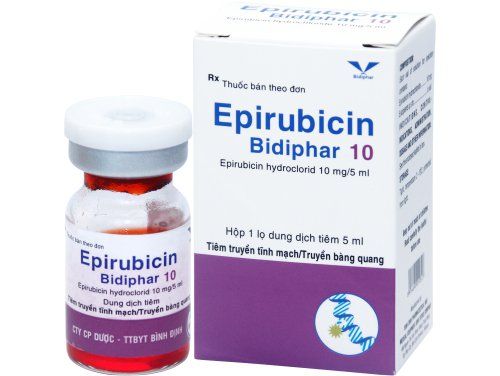This is an automatically translated article.
Tamifine 10mg is an anti-cancer drug, indicated for the treatment of breast cancer and the treatment of anovulatory infertility. The following article provides you with information about the uses, dosage and precautions when using Tamifine 10mg.
1. Uses of Tamifine 10mg
Tamifine has the main active ingredient Tamoxifen citrate, the drug is made in the form of tablets with a strength of 10mg. Tamoxifen belongs to the triphenylethylene group, a non-steroidal anti-inflammatory drug with a combined action of pharmacological effects similar to oestrogen-agonists and oestrogen-antagonists in various tissues of the body.
In breast cancer patients, Tamoxifen prevents estrogen from binding to the oestrogen receptor at the tumor. In addition, clinical reports found that, Tamoxifen reduced blood levels of total and LDL cholesterol, maintaining bone mineral density in postmenopausal women.
2. Indications and contraindications of Tamifine 10mg
2.1. Indications Tamifine 10mg is used in the treatment of breast cancer. In addition, the drug is also indicated in the treatment of anovulatory infertility.
2.2.Contraindications Allergy or hypersensitivity to Tamoxifen citrate or any ingredient of Tamifine. Pregnant women. Before initiating treatment for breast cancer and infertility in premenopausal patients, the possibility of pregnancy should be excluded. Concomitant use of Tamifine with Anastrozole.
3. How to use Tamifine 10mg
Tamifine 10mg for oral use.
3.1 Dosage for breast cancer treatment
Usual dose: 20mg/day, divided orally 1-2 times. Up to 40mg/day can be used, but no additional benefit has been seen.
Treatment of infertility due to anovulation
Exclusion of pregnancy in women prior to initiation of treatment and prior to initiation of the next course of treatment.
Women with regular menstrual periods but not ovulating: the first course of treatment is 20 mg/day, orally on the 2nd, 3rd, 4th and 5th days of the menstrual cycle. If no response (based on basal temperature or pre-ovulatory cervical mucus monitoring) use up to 40 mg then 80 mg/day during the next course of treatment. Women with irregular periods : the first course of treatment can be started on any day. If there is no evidence of ovulation, continue with a second course, starting 45 days later, with the dose of Tamifine increased as above. If the treatment responds, the next course begins on day 2 of the menstrual cycle. Use in Children
The effectiveness and safety of Tamifine in children have not been established, therefore Tamifine is not recommended for use in children.
3.2 Tamifine 10mg overdose and management Theoretically, the overdose of Tamifine increases the pharmacological effects of the drug. Experimental observations on animals have shown that very high doses of Tamoxifen (100-200 times the daily dose) can induce oestrogenic effects.
There have been reports when taking Tamoxifen at doses several times the standard dose associated with prolongation of the QT interval on the electrocardiogram.
Currently, there is no specific antidote for Tamifine overdose and treatment is mainly symptomatic.
4. Note when using Tamifine 10mg
During breast cancer treatment with Tamifine, some premenopausal patients may experience amenorrhea.
An increase in the frequency of endometrial disorders including: hyperplasia, uterine polyps, endometrial cancer and uterine sarcoma (mostly malignant mixed mullarian tumors) has been reported. related to Tamoxifen. The mechanism is unknown but may be related to Tamoxifen's oestrogen-like properties. Monitor patients who have been taking Tamoxifen for unusual gynecological symptoms, especially vaginal bleeding, menstrual disorders, pelvic pain or heaviness.
A second primary tumor occurring outside of the endometrium and the remaining breast has been reported in clinical trials in breast cancer patients following Tamoxifen therapy. A causal relationship has not been established and the clinical significance of this observation remains unclear.
Venous thromboembolism (VTE) Healthy women using Tamoxifen have been shown to have a 2-3 times increased risk of venous thromboembolism.
The patient and family history of venous thromboembolism should be considered. If the patient is at risk for thrombosis, the patient's predisposing factors for thrombosis should be examined. All patients should carefully consider the risks and benefits prior to treatment with Tamifine. The decision to use Tamifine is based on the overall risk to the patient. In selected patients, use of Tamifine together with prophylactic anticoagulation may be beneficial. If the patient presents with venous thromboembolism, Tamifine should be discontinued and appropriate therapy instituted.
Pregnant women Tamifine is contraindicated in pregnant women. Spontaneous abortion, fetal malformation, and stillbirth have been reported in pregnant women taking Tamoxifen, although a causal relationship has not been established.
Reproductive toxicity studies in rats, rabbits and monkeys indicate that Tamoxifen has no teratogenic potential.
For fetal reproductive development in rodents, Tamoxifen was associated with changes similar to those induced by oestradiol, ethynyl- oestradiol, diethylstilbestrol, clomiphene.
Lactating women It is not known whether Tamifine 10mg is excreted in human milk. Tamifine is not recommended during lactation. The decision to discontinue nursing or discontinue Tamifine depends on how important Tamifine 10mg is to the mother.
5. Tamifine 10mg . side effects
Some unwanted effects may be encountered when using Tamifine 10mg such as hot flushes, skin reactions around the tumor, vulvar itching, vaginal bleeding, vaginal discharge; common headaches, dizziness, digestive disorders and less commonly body fluid retention, hair loss.
If these undesirable effects become more severe, they should be managed by reducing the dose (not less than 20 mg/day) without affecting disease control. If symptoms do not improve even with dose reduction, therapy may be discontinued.
Some other side effects that may be encountered when using Tamifine include:
Skin rashes such as Stevens-Johnson syndrome, erythema multiforme, bullous pemphigot and hypersensitivity reactions. Hypercalcemia may occur in a small number of patients with bone metastases at the start of treatment. Thrombocytopenia, to 80,000-90,000/mm3 and sometimes less, has been reported in breast cancer patients treated with Tamoxifen. Visual disturbances, abnormal changes in the cornea and retinopathy, cataracts. Optic neuropathy, optic neuritis and even blindness. Uterine fibroids, endometriosis and other endometrial changes such as hyperplasia, polyps, endometrial cancer and uterine sarcoma (mostly malignant mixed Mullarian tumors). Ovarian cysts are sometimes observed in premenopausal women. Leukopenia, neutropenia, sometimes associated with anemia or thrombocytopenia. Increased frequency of ischemic stroke and thromboembolic events including deep vein thrombosis and pulmonary embolism. Concomitant administration of Tamoxifen with cytotoxic agents may increase the risk of thromboembolic events. Leg cramps Interstitial pneumonia. Changes in liver enzyme levels, fatty liver, cholestasis and hepatitis. Increased serum triglyceride levels, pancreatitis may occur.
6. Tamifine 10mg . drug interactions
Coumarin-type anticoagulants: Tamoxifen may increase the anticoagulant effect. Cytotoxic agents for the treatment of breast cancer: Concomitant administration of Tamifine may increase the risk of thromboembolic events. Therefore, thromboprophylaxis should be considered in patients during combination chemotherapy. Rifampicin: Concomitant use may reduce Tamoxifen concentrations. Tamifine 10mg is an anti-cancer drug, indicated for the treatment of breast cancer and for the treatment of anovulatory infertility. To ensure the effectiveness of treatment and avoid unwanted side effects, patients need to take the drug exactly as directed by a doctor or pharmacist.
Follow Vinmec International General Hospital website to get more health, nutrition and beauty information to protect the health of yourself and your loved ones in your family.
Please dial HOTLINE for more information or register for an appointment HERE. Download MyVinmec app to make appointments faster and to manage your bookings easily.













